Spatio-Temporal Development of Vegetation Carbon Sinks and Sources in the Arid Region of Northwest China
Abstract
1. Introduction
2. Materials and Methods
2.1. Study Area
2.2. Materials
2.3. Methods
2.3.1. Net Ecosystem Production Algorithm
2.3.2. NPP Estimation Using the CASA Model
2.3.3. Fraction of Vegetation Cover (FVC) Calculation
2.3.4. Remote Sensing Ecological Index (RSEI) Estimation
3. Results
3.1. Spatial Distribution of Vegetation Carbon Sinks/Sources
3.2. Temporal Variations of Vegetation Carbon Sinks/Sources
3.3. Spatial Variations of Vegetation Carbon Sinks/Sources
3.3.1. Spatial Variations of Vegetation Carbon Sinks/Sources in Different Basins
3.3.2. Spatial Distributions and Variations of Carbon Sinks/Sources at Different Altitudes
4. Discussion
4.1. Influence Factors of Vegetation Carbon Sinks/Sources Changes
4.1.1. Climate Changes
4.1.2. NDVI and FVC Changes
4.1.3. Human Activities
4.2. Ecological Security Assessment
5. Conclusions
Author Contributions
Funding
Institutional Review Board Statement
Informed Consent Statement
Data Availability Statement
Conflicts of Interest
References
- Mitchard, E.T.A. The tropical forest carbon cycle and climate change. Nature 2018, 559, 527–534. [Google Scholar] [CrossRef] [PubMed]
- Tang, R.; He, B.; Chen, H.W.; Chen, D.L.; Chen, Y.N.; Fu, Y.H.; Yuan, W.P.; Li, B.F.; Li, Z.; Guo, L.L.; et al. Increasing terrestrial ecosystem carbon release in response to autumn cooling and warming. Nat. Clim. Change 2022, 12, 380–385. [Google Scholar] [CrossRef]
- Bai, Y.F.; Cotrufo, M.F. Grassland soil carbon sequestration: Current understanding, challenges, and solutions. Science 2022, 377, 603–608. [Google Scholar] [CrossRef] [PubMed]
- Luyssaert, S.; Schulze, E.D.; Börner, A.; Knohl, A.; Hessenmöller, D.; Law, B.E.; Ciais, P.; Grace, J. Old-growth forests as global carbon sinks. Nature 2008, 455, 213–215. [Google Scholar] [CrossRef]
- Zhang, J.J.; Hao, X.M.; Hao, H.C.; Fan, X.; Li, Y.H. Climate Change Decreased Net Ecosystem Productivity in the Arid Region of Central Asia. Remote Sens. 2021, 13, 4449. [Google Scholar] [CrossRef]
- Li, Z.; Chen, Y.N.; Zhang, Q.F.; Li, Y. Spatial patterns of vegetation carbon sinks and sources under water constraint in Central Asia. J. Hydrol. 2020, 590, 125355. [Google Scholar] [CrossRef]
- Yao, Y.T.; Li, Z.L.; Wang, T.; Chen, A.P.; Wang, X.H.; Du, M.Y.; Jia, G.S.; Li, Y.N.; Li, H.Q.; Luo, W.J.; et al. A new estimation of China’s net ecosystem productivity based on eddy covariance measurements and a model tree ensemble approach. Agr. Forest Meteorol. 2018, 253–254, 84–93. [Google Scholar] [CrossRef]
- Cheng, L.; Zhang, L.; Wang, Y.P.; Canadell, J.G.; Chiew, F.H.S.; Beringer, J.; Li, L.H.; Miralles, D.G.; Piao, S.L.; Zhang, Y.Q. Recent increases in terrestrial carbon uptake at little cost to the water cycle. Nat. Commun. 2017, 8, 110. [Google Scholar] [CrossRef]
- IPCC. Working Group I Contribution to the IPCC Fifth Assessment Report, Climate Change 2013: The Physical Science Basis: Summary for Policymakers; Cambridge University Press: Cambridge, UK, 2013. [Google Scholar]
- Li, Z.; Chen, Y.N.; Wang, Y.; Fang, G.H. Dynamic changes in terrestrial net primary production and their effects on evapotranspiration. Hydrol. Earth Syst. Sc. 2016, 20, 2169–2178. [Google Scholar] [CrossRef]
- Li, Y.P.; Chen, Y.N.; Li, Z. Dry/wet pattern changes in global dryland areas over the past six decades. Global Planet. Change 2019, 178, 184–192. [Google Scholar] [CrossRef]
- D’Odorico, P.; Porporato, A.; Runyan, C.W. Dryland Ecohydrology; Springer: Berlin/Heidelberg, Germany, 2019. [Google Scholar]
- Wang, L.; D’Odorico, P.; Evans, J.P.; Eldridge, D.J.; McCabe, M.F.; Caylor, K.K.; King, E.G. Dryland ecohydrology and climate change: Critical issues and technical advances. Hydrol. Earth Syst. Sc. 2012, 16, 2585–2603. [Google Scholar] [CrossRef]
- Huang, J.P.; Xie, Y.K.; Guan, X.D.; Li, D.D.; Ji, F. The dynamics of the warming hiatus over the Northern Hemisphere. Clim. Dynam. 2017, 48, 429–446. [Google Scholar] [CrossRef]
- Ahlstrom, A.; Raupach, M.R.; Schurgers, G.; Smith, B.; Arneth, A.; Jung, M.; Reichstein, M.; Canadell, J.G.; Friedlingstein, P.; Jain, A.K.; et al. Carbon cycle. The dominant role of semi-arid ecosystems in the trend and variability of the land CO2 sink. Science 2015, 348, 895–899. [Google Scholar] [CrossRef] [PubMed]
- Huang, J.P.; Yu, H.P.; Guan, X.D.; Wang, G.Y.; Guo, R.X. Accelerated dryland expansion under climate change. Nat. Clim. Change 2016, 6, 166–171. [Google Scholar] [CrossRef]
- Huang, J.; Li, Y.; Fu, C.B.; Chen, F.H.; Fu, Q.; Dai, A.; Shinoda, M.; Ma, Z.G.; Guo, W.D.; Li, Z.Q.; et al. Dryland Climate Change: Recent Progress and Challenges: Dryland Climate Change. Rev. Geophys. 2017, 55, 719–778. [Google Scholar] [CrossRef]
- Li, C.J.; Fu, B.J.; Wang, S.; Stringer, L.C.; Wang, Y.P.; Li, Z.D.; Liu, Y.X.; Zhou, W.X. Drivers and impacts of changes in China’s drylands. Nat. Rev. Earth Environ. 2021, 2, 858–873. [Google Scholar] [CrossRef]
- Yu, Y.; Pi, Y.Y.; Yu, X.; Ta, Z.J.; Sun, L.X.; Disse, M.; Zeng, F.J.; Li, Y.M.; Chen, X.; Yu, R.D. Climate change, water resources and sustainable development in the arid and semi-arid lands of Central Asia in the past 30 years. J. Arid Land. 2019, 11, 1–14. [Google Scholar] [CrossRef]
- Wang, J.; Liu, D.W.; Ma, J.L.; Cheng, Y.N.; Wang, L.X. Development of a large-scale remote sensing ecological index in arid areas and its application in the Aral Sea Basin. J. Arid Land. 2021, 13, 40–55. [Google Scholar] [CrossRef]
- Zhang, T.J.; Chen, Y.N. The effects of landscape change on habitat quality in arid desert areas based on future scenarios: Tarim River Basin as a case study. Front. Plant Sci. 2022, 13, 1031859. [Google Scholar] [CrossRef]
- Yao, J.Q.; Chen, Y.N.; Guan, X.F.; Zhao, Y.; Chen, J.; Mao, W.Y. Recent climate and hydrological changes in a mountain-basin system in Xinjiang, China. Earth Sci. Rev. 2022, 226, 103957. [Google Scholar] [CrossRef]
- Kou, D.; Ma, W.H.; Ding, J.Z.; Zhang, B.B.; Fang, K.; Hu, H.F.; Yu, J.C.; Wang, T.; Qin, S.Q.; Zhao, X.; et al. Dryland soils in northern China sequester carbon during the early 2000s warming hiatus period. Funct. Ecol. 2018, 32, 1620–1630. [Google Scholar] [CrossRef]
- Ciais, P.; Reichstein, M.; Viovy, N.; Granier, A.; Ogée, J.; Allard, V.; Aubinet, M.; Buchmann, N.; Bernhofer, C.; Carrara, A.; et al. Europe-wide reduction in primary productivity caused by the heat and drought in 2003. Nature 2005, 437, 529–533. [Google Scholar] [CrossRef]
- Chen, Y.N.; Zhang, X.Q.; Fang, G.H.; Li, Z.; Wang, F.; Qin, J.X.; Sun, F. Potential risks and challenges of climate change in the arid region of northwestern China. Reg. Sustain. 2020, 1, 20–30. [Google Scholar] [CrossRef]
- Le Quéré, C.; Raupach, M.R.; Canadell, J.G.; Marland, G.; Bopp, L.; Ciais, P.; Conway, T.J.; Doney, S.C.; Feely, R.A.; Foster, P.; et al. Trends in the sources and sinks of carbon dioxide. Nat. Geosci. 2009, 2, 831–836. [Google Scholar] [CrossRef]
- Keenan, T.F.; Williams, C.A. The terrestrial carbon sink. Annu. Rev. Env. Resour. 2018, 43, 219–243. [Google Scholar] [CrossRef]
- Wylie, B.K.; Fosnight, E.A.; Gilmanov, T.G.; Frank, A.B.; Morgan, J.A.; Haferkamp, M.R.; Meyers, T.P. Adaptive data-driven models for estimating carbon fluxes in the Northern Great Plains. Remote Sens. Environ. 2007, 106, 399–413. [Google Scholar] [CrossRef]
- Zhao, F.B.; Wu, Y.P.; Qiu, L.J.; Sivakumar, B.; Zhang, F.; Sun, Y.Z.; Sun, L.Q.; Li, Q.; Voinov, A. Spatiotemporal features of the hydro-biogeochemical cycles in a typical loess gully watershed. Ecol. Indic. 2018, 91, 542–554. [Google Scholar] [CrossRef]
- Zhang, Q.F.; Sun, C.J.; Chen, Y.N.; Chen, W.; Xiang, Y.Y.; Li, J.; Liu, Y.T. Recent Oasis Dynamics and Ecological Security in the Tarim River Basin, Central Asia. Sustainability 2022, 14, 3372. [Google Scholar] [CrossRef]
- Bonan, G.B. Forests and Climate Change: Forcings, Feedbacks, and the Climate Benefits of Forests. Science 2008, 320, 1444–1449. [Google Scholar] [CrossRef]
- Hao, X.M.; Li, W.H.; Deng, H.J. The oasis effect and summer temperature rise in arid regions-case study in Tarim Basin. Sci. Rep. 2016, 6, 35418. [Google Scholar] [CrossRef]
- Li, Y.P.; Chen, Y.N.; Li, Z.; Fang, G.H. Recent recovery of surface wind speed in northwest China. Int. J. Climatol. 2018, 38, 4445–4458. [Google Scholar] [CrossRef]
- Yao, J.Q.; Zhao, Y.; Chen, Y.N.; Yu, X.; Zhang, R.B. Multi-scale assessments of droughts: A case study in Xinjiang, China. Sci. Total Environ. 2018, 630, 444–452. [Google Scholar] [CrossRef] [PubMed]
- Sun, F.; Wang, Y.; Chen, Y.N.; Li, Y.; Zhang, Q.; Qin, J.X.; Kayumba, P.M. Historic and Simulated Desert-Oasis Ecotone Changes in the Arid Tarim River Basin, China. Remote Sens. 2021, 13, 647. [Google Scholar] [CrossRef]
- Deng, H.; Yin, Y.; Wu, S.; Xu, X. Contrasting drought impacts on the start of phenological growing season in Northern China during 1982–2015. Int. J. Climatol. 2020, 40, 3330–3347. [Google Scholar] [CrossRef]
- Potter, C.S.; Randerson, J.T.; Field, C.B.; Matson, P.A.; Vitousek, P.M.; Mooney, H.A.; Klooster, S.A. Terrestrial ecosystem production; a process model based on global satellite and surface data. Global Biogeochem. Cy. 1993, 7, 811–841. [Google Scholar] [CrossRef]
- Coutts, A.M.; Harris, R.J.; Phan, T.; Livesley, S.J.; Williams, N.S.G.; Tapper, N.J. Thermal infrared remote sensing of urban heat: Hotspots, vegetation, and an assessment of techniques for use in urban planning. Remote Sens. Environ. 2016, 186, 637–651. [Google Scholar] [CrossRef]
- Mishra, N.B.; Crews, K.A.; Neeti, N.; Meyer, T.; Young, K.R. MODIS derived vegetation greenness trends in African Savanna: Deconstructing and localizing the role of changing moisture availability, fire regime and anthropogenic impact. Remote Sens. Environ. 2015, 169, 192–204. [Google Scholar] [CrossRef]
- Li, Z.; Chen, Y.N.; Li, W.H.; Deng, H.J.; Fang, G.H. Potential impacts of climate change on vegetation dynamics in Central Asia. J. Geophys. Res. Atmos. 2015, 120, 12345–12356. [Google Scholar] [CrossRef]
- Liu, M.Y.; Liu, M.M.; Li, P.; Yang, J.H.; Wang, J.; Chang, Q.R. Variations in soil organic carbon decompositions of different land use patterns on the tableland of Loess Plateau. Environ. Sci. Pollut. R. 2020, 27, 4337–4352. [Google Scholar] [CrossRef]
- Xu, Z.H.; Fan, W.G.; Wei, H.J.; Zhang, P.; Ren, J.H.; Gao, Z.C.; Ulgiati, S.; Kong, W.D.; Dong, X.B. Evaluation and simulation of the impact of land use change on ecosystem services based on a carbon flow model: A case study of the Manas River Basin of Xinjiang, China. Sci. Total Environ. 2019, 652, 117–133. [Google Scholar] [CrossRef]
- Wang, M.; Chen, H.; Yu, Z.C.; Wu, J.H.; Zhu, Q.A.; Peng, C.H.; Wang, Y.F.; Qin, B.Q. Carbon accumulation and sequestration of lakes in China during the Holocene. Global Change Biol. 2015, 21, 4436–4448. [Google Scholar] [CrossRef] [PubMed]
- Raymond, P.A.; Hartmann, J.; Lauerwald, R.; Sobek, S.; McDonald, C.; Hoover, M.; Butman, D.; Striegl, R.; Mayorga, E.; Humborg, C.; et al. Global carbon dioxide emissions from inland waters. Nature 2013, 503, 355–359. [Google Scholar] [CrossRef] [PubMed]
- Chen, F.H.; Huang, W.; Jin, L.Y.; Chen, J.H.; Wang, J.S. Spatiotemporal precipitation variations in the arid Central Asia in the context of global warming. Sci. China Earth Sci. 2011, 54, 1812–1821. [Google Scholar] [CrossRef]
- Luo, M.; Liu, T.; Meng, F.H.; Duan, Y.C.; Bao, A.M.; Frankl, A.; De Maeyer, P. Spatiotemporal characteristics of future changes in precipitation and temperature in Central Asia. Int. J. Climatol. 2019, 39, 1571–1588. [Google Scholar] [CrossRef]
- Zhang, Y.; An, C.B.; Liu, L.Y.; Zhang, Y.Z.; Lu, C.; Zhang, W.S. High Mountains Becoming Wetter While Deserts Getting Drier in Xinjiang, China since the 1980s. Land 2021, 10, 1131. [Google Scholar] [CrossRef]
- Chen, Y.N.; Li, Z.; Li, W.H.; Deng, H.J.; Shen, Y.J. Water and ecological security: Dealing with hydroclimatic challenges at the heart of China’s Silk Road. Environ. Earth Sci. 2016, 75, 881. [Google Scholar] [CrossRef]
- Hao, H.C.; Chen, Y.N.; Xu, J.H.; Li, Z.; Li, Y.P.; Kayumba, P.M. Water Deficit May Cause Vegetation Browning in Central Asia. Remote Sens. 2022, 14, 2574. [Google Scholar] [CrossRef]
- Zhang, Q.F.; Chen, Y.N.; Li, Z.; Fang, G.H.; Xiang, Y.Y.; Li, Y.P. Controls on Alpine Lake Dynamics, Tien Shan, Central Asia. Remote Sens. 2022, 14, 4698. [Google Scholar] [CrossRef]
- Zhang, Q.F.; Chen, Y.N.; Li, Z.; Fang, G.H.; Xiang, Y.Y.; Ji, H.P. Why are glacial lakes in the eastern Tianshan Mountains expanding at an accelerated rate? J. Geogr. Sci. 2023, 33, 121–150. [Google Scholar] [CrossRef]
- Zhang, Q.F.; Chen, Y.N.; Li, Z.; Fang, G.H.; Xiang, Y.Y.; Li, Y.P.; Ji, H.P. Recent Changes in Water Discharge in Snow and Glacier Melt-Dominated Rivers in the Tienshan Mountains, Central Asia. Remote Sens. 2020, 12, 2704. [Google Scholar] [CrossRef]
- Gao, L.; Deng, H.J.; Lei, X.Y.; Wei, J.H.; Chen, Y.N.; Li, Z.Q.; Ma, M.M.; Chen, X.W.; Chen, Y.; Liu, M.B.; et al. Evidence for elevation-dependent warming from the Chinese Tianshan Mountains. Cryosphere 2021, 15, 5765–5783. [Google Scholar] [CrossRef]
- Zhou, Z.H.; Han, N.; Liu, J.J.; Yan, Z.Q.; Xu, C.Y.; Cai, J.Y.; Shang, Y.Z.; Zhu, J.S. Glacier variations and their response to climate change in an arid inland river basin of Northwest China. J. Arid Land 2020, 12, 357–373. [Google Scholar] [CrossRef]
- Zhang, Q.F.; Chen, Y.N.; Li, Z.; Xiang, Y.Y.; Li, Y.P.; Sun, C.J. Recent Changes in Glaciers in the Northern Tien Shan, Central Asia. Remote Sens. 2022, 14, 2878. [Google Scholar] [CrossRef]
- Li, Z.X.; Yuan, R.F.; Feng, Q.; Zhang, B.J.; Lv, Y.M.; Li, Y.G.; Wei, W.; Chen, W.; Ning, T.T.; Gui, J.; et al. Climate background, relative rate, and runoff effect of multiphase water transformation in Qilian Mountains, the third pole region. Sci. Total Environ. 2019, 663, 315–328. [Google Scholar] [CrossRef] [PubMed]
- Xu, X.J.; Jiao, F.S.; Liu, H.Y.; Gong, H.B.; Zou, C.X.; Lin, N.F.; Xue, P.; Zhang, M.Y.; Wang, K.L. Persistence of increasing vegetation gross primary production under the interactions of climate change and land use changes in Northwest China. Sci. Total Environ. 2022, 834, 155086. [Google Scholar] [CrossRef]
- Liang, Y.J.; Liu, L.L.; Hashimoto, S. Spatiotemporal analysis of trends in vegetation change across an artificial desert oasis, Northwest China, 1975–2010. Arab. J. Geosci. 2020, 13, 742. [Google Scholar] [CrossRef]
- Wang, J.; Xie, Y.W.; Wang, X.Y.; Guo, K.M. Driving Factors of Recent Vegetation Changes in Hexi Region, Northwest China Based on a New Classification Framework. Remote Sens. 2020, 12, 1758. [Google Scholar] [CrossRef]
- Amuti, T.; Luo, G. Analysis of land cover change and its driving forces in a desert oasis landscape of Xinjiang, northwest China. Solid Earth 2014, 5, 1071–1085. [Google Scholar] [CrossRef]
- Hou, Y.F.; Chen, Y.N.; Ding, J.L.; Li, Z.; Li, Y.P.; Sun, F. Ecological Impacts of Land Use Change in the Arid Tarim River Basin of China. Remote Sens. 2022, 14, 1894. [Google Scholar] [CrossRef]
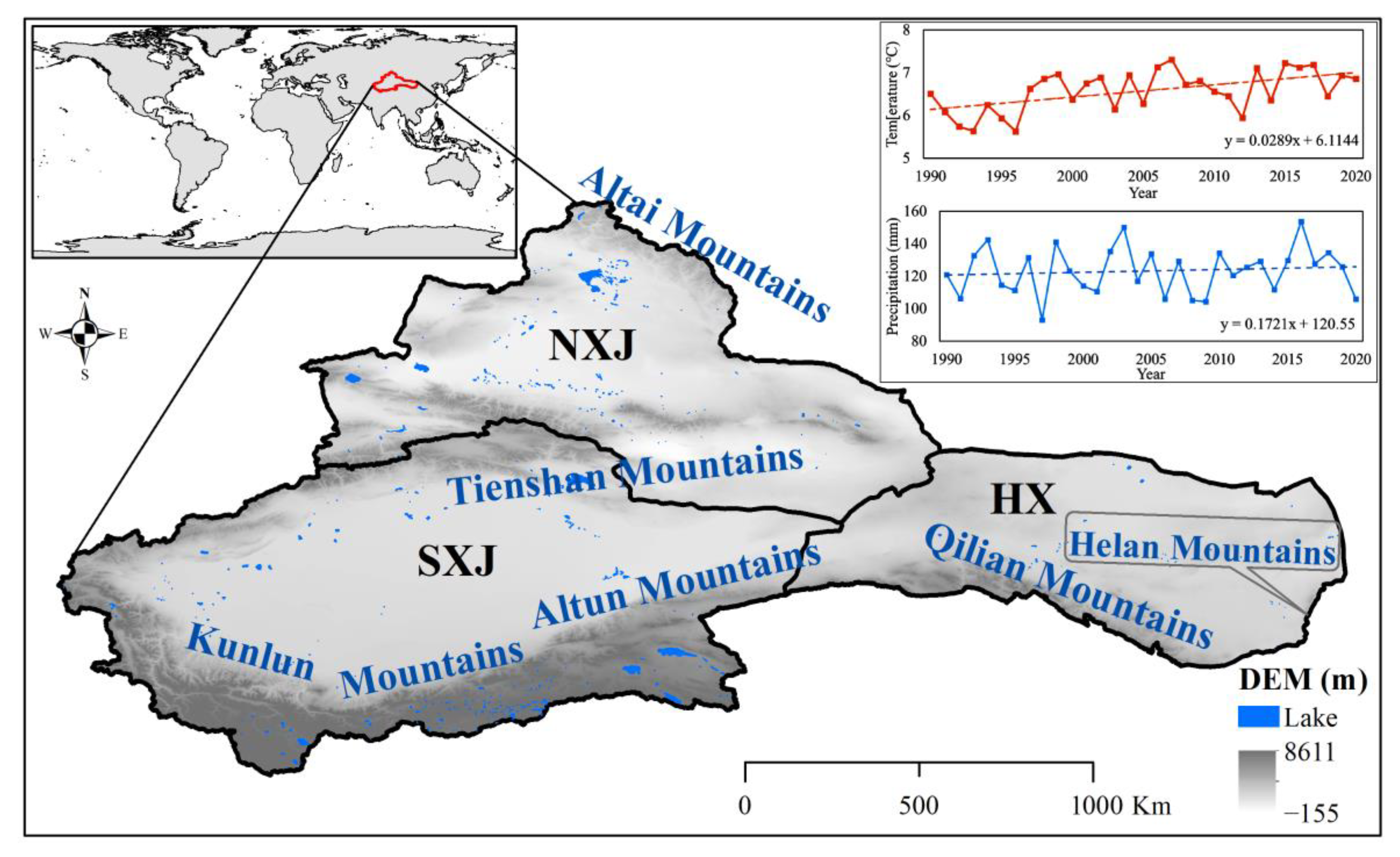

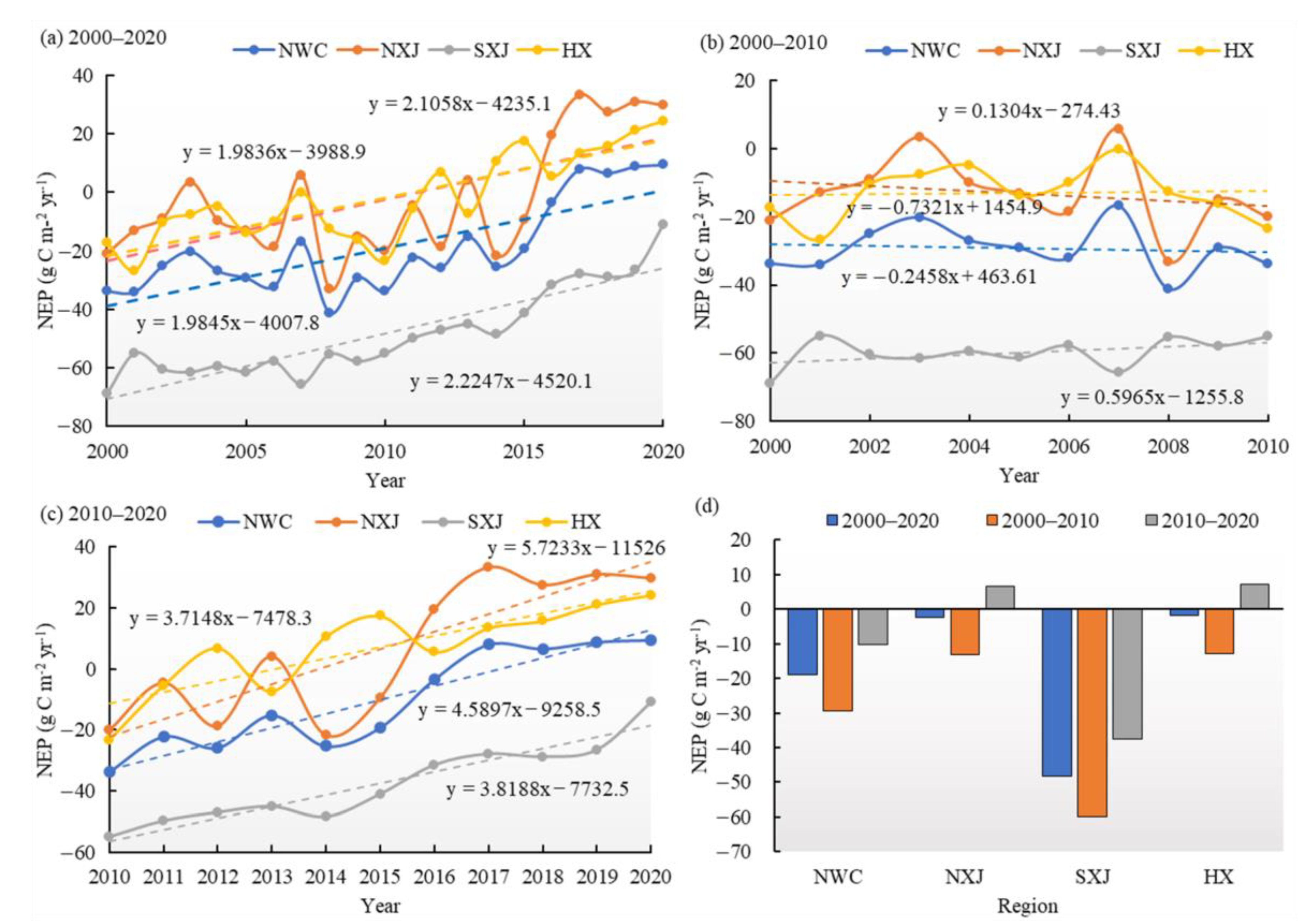

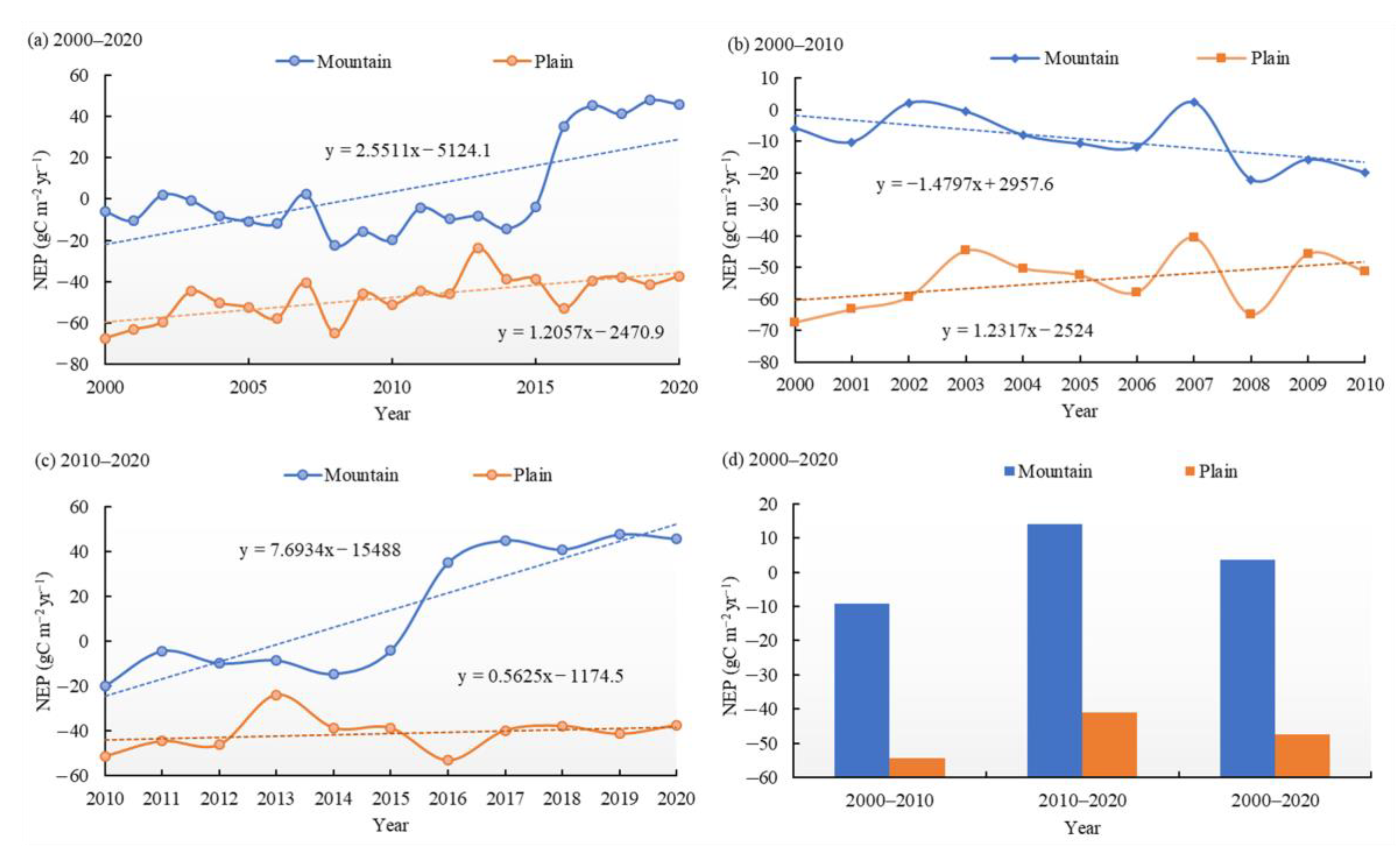


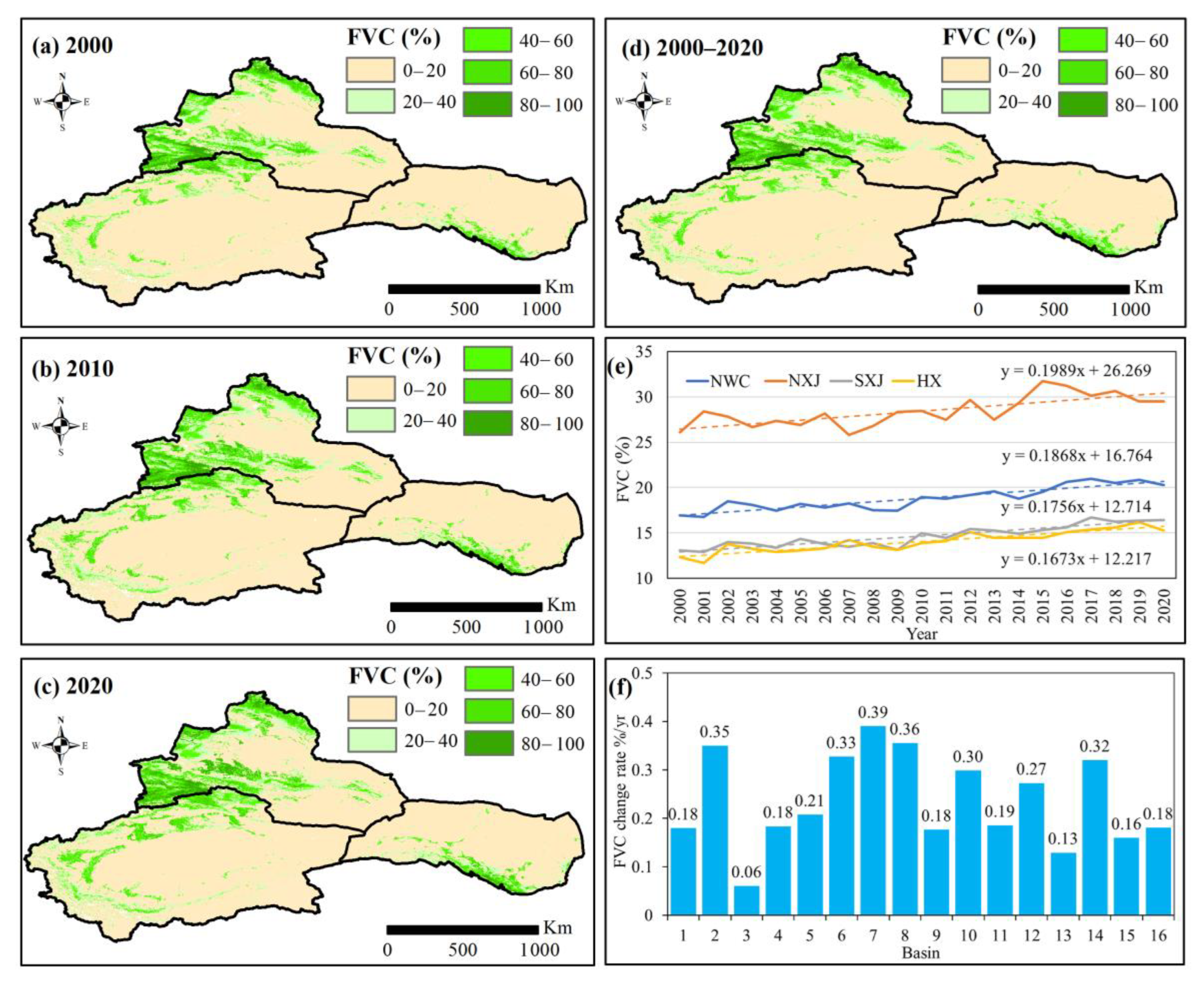

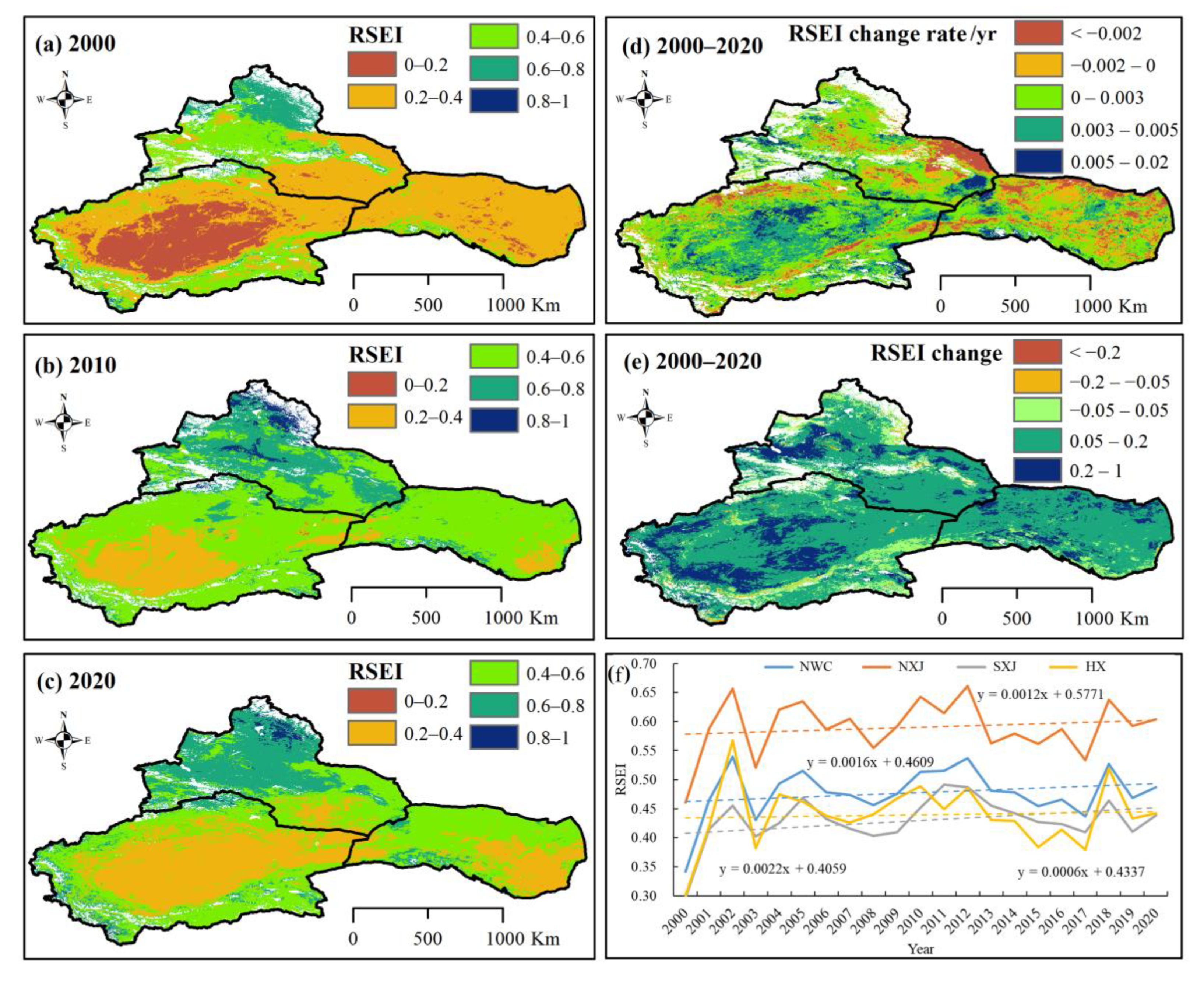
| Data Products | Variables | Spatial Resolution | Temporal Resolution | Data Sources |
|---|---|---|---|---|
| MOD13Q1 | NDVI | 250 m | 16 d | https://modis.gsfc.nasa.gov/ accessed on 27 September 2022 |
| MOD09A1 | SR | 500 m | 8 d | https://modis.gsfc.nasa.gov/ accessed on 12 November 2022 |
| MOD11A2 | LST | 1 km | 8 d | https://modis.gsfc.nasa.gov/ accessed on 12 November 2022 |
| MOD15A3H | FPAR | 500 m | 4 d | https://modis.gsfc.nasa.gov/ accessed on 27 September 2022 |
| MOD17A3H | NPP | 500 m | Yearly | https://modis.gsfc.nasa.gov/ accessed on 10 January 2023 |
| MCD12Q1 | Landcover (IGBP) | 500 m | 96 d | https://modis.gsfc.nasa.gov/ accessed on 27 September 2022 |
| TerraClimate | Pre/SOL | 4 km | Monthly | https://www.ecmwf.int accessed on 27 September 2022 |
| T3H(GLDAS) | Tem | 0.25° | 3 h | http:/ldas.gsfc.nasa.gov/ accessed on 27 September 2022 |
| LUCC Data | Landcover | 30 m | 5 year | http://www.resdc.cn/ accessed on 25 August 2022 |
| CRU TSV4.06 | Pre/Tem | 0.5° | Monthly | https://crudata.uea.ac.uk/cru/data/hrg/#info accessed on 19 September 2022 |
| SRTM | DEM | 90 m | - | https://glovis.usgs.gov/ accessed on 2 September 2022 |
| Variables | NEP | NPP | NDVI | FVC | RSEI | TEM | PRE | RH |
|---|---|---|---|---|---|---|---|---|
| NEP | 1 | 0.96 ** | 0.83 ** | 0.88 ** | 0.08 | 0.30 | 0.31 | 0.18 |
| NPP | 1 | 0.89 ** | 0.93 ** | 0.10 | 0.29 | 0.40 | 0.32 | |
| NDVI | 1 | 0.98 ** | 0.19 | 0.23 | 0.42 | 0.43 | ||
| FVC | 1 | 0.25 | 0.24 | 0.44 * | 0.38 | |||
| RSEI | 1 | −0.14 | 0.13 | 0.10 | ||||
| TEM | 1 | −0.06 | 0.36 | |||||
| PRE | 1 | 0.48 * | ||||||
| RH | 1 |
| Region | Variables | High FVC | Higher FVC | Medium FVC | Lower FVC | Low FVC |
|---|---|---|---|---|---|---|
| NWC | Average (%) | 84.79 | 69.77 | 49.86 | 28.11 | 9.04 |
| Slope | −0.01 | 0.04 | −0.005 | −0.01 | 0.05 | |
| Z value | 0 | 4.62 ** | −1.96 * | −2.81 * | 4.92 ** | |
| NXJ | Average (%) | 84.93 | 70.37 | 49.86 | 28.24 | 10.73 |
| Slope | −0.002 | 0.04 | −0.004 | −0.02 | 0.05 | |
| Z value | 0.27 | 4.14 ** | −0.75 | −1.90 | 3.96 ** | |
| SXJ | Average (%) | 84.19 | 68.53 | 49.86 | 28.17 | 8.11 |
| Slope | −0.03 | 0.08 | −0.002 | −0.004 | 0.05 | |
| Z value | −2.14 * | 3.71 ** | −0.63 | −1.60 | 4.74 ** | |
| HX | Average (%) | 83.41 | 69.76 | 49.90 | 27.51 | 9.28 |
| Slope | 0.07 | 0.06 | −0.02 | −0.01 | 0.06 | |
| Z value | 3.96 ** | 3.59 ** | −2.39 * | −0.75 | 4.38 ** |
Disclaimer/Publisher’s Note: The statements, opinions and data contained in all publications are solely those of the individual author(s) and contributor(s) and not of MDPI and/or the editor(s). MDPI and/or the editor(s) disclaim responsibility for any injury to people or property resulting from any ideas, methods, instructions or products referred to in the content. |
© 2023 by the authors. Licensee MDPI, Basel, Switzerland. This article is an open access article distributed under the terms and conditions of the Creative Commons Attribution (CC BY) license (https://creativecommons.org/licenses/by/4.0/).
Share and Cite
Zhang, Q.; Chen, Y.; Li, Z.; Sun, C.; Xiang, Y.; Liu, Z. Spatio-Temporal Development of Vegetation Carbon Sinks and Sources in the Arid Region of Northwest China. Int. J. Environ. Res. Public Health 2023, 20, 3608. https://doi.org/10.3390/ijerph20043608
Zhang Q, Chen Y, Li Z, Sun C, Xiang Y, Liu Z. Spatio-Temporal Development of Vegetation Carbon Sinks and Sources in the Arid Region of Northwest China. International Journal of Environmental Research and Public Health. 2023; 20(4):3608. https://doi.org/10.3390/ijerph20043608
Chicago/Turabian StyleZhang, Qifei, Yaning Chen, Zhi Li, Congjian Sun, Yanyun Xiang, and Zhihui Liu. 2023. "Spatio-Temporal Development of Vegetation Carbon Sinks and Sources in the Arid Region of Northwest China" International Journal of Environmental Research and Public Health 20, no. 4: 3608. https://doi.org/10.3390/ijerph20043608
APA StyleZhang, Q., Chen, Y., Li, Z., Sun, C., Xiang, Y., & Liu, Z. (2023). Spatio-Temporal Development of Vegetation Carbon Sinks and Sources in the Arid Region of Northwest China. International Journal of Environmental Research and Public Health, 20(4), 3608. https://doi.org/10.3390/ijerph20043608









